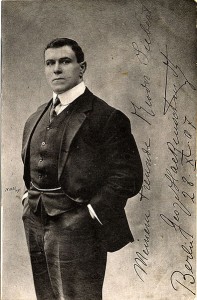Hack and What It Takes To Be Great
George Hackenschmidt (1877-1968) bija pasaules rekords saimniecības svarcēlājs un Pasaules Heavyweight Wrestling čempions pirms cīņas bija iepriekš sagatavots un pacēlāji bija, izmantojot steroīdi. Hackenschmidt sasniegusi līmeni diženumu saistīts ar vairākiem faktoriem.
Viņš sasniedza augstu fiziskās sagatavotības. His physical condition allowed him to be the most successful wrestler of his era. A few wrestlers may have been better technicians but Hackenschmidt was the strongest. He often overpowered his opponents and was very difficult to throw. He is only known to have lost to Frank Gotch as a professional.
He was adaptable. George never locked himself into one way of thinking where he never changed. Hackenschmidt originally wrestled Greco-Roman style. Despite winning the world championship with this style, he switched to catch as catch can wrestling around 1904. He defended his title in this style until he lost to Frank Gotch in 1908.
He had perseverance. Hackenschmidt was undefeated world champion for seven years from 1901 līdz 1908. Most people can only stay on top of the world for a couple years. To be undefeated for seven years in almost 3000 matches is an incredible record. He had to bring his “A” game each night.
Besides his wrestling exploits, George Hackenschmidt was also considered the strongest man in the world at the turn of the century. He held records in the Bench Press, Hack Squat, uc. He actually invented the Hack Squat, which is named in his honor.
George Hackenschmidt met Frank Gotch on April 3, 1908 in Chicago, IL. Gotch finally ended Hackenschmidt’s undefeated streak. Septembrī 4, 1911, Gotch and Hackenschmidt had their rematch with the same result. Hackenschmidt, who was suffering from “housemaid’s knee”, decided to retire.
He stayed active in fitness training though. He wrote How to Live in Strength and Health (filiāli saite) and continued training people. In his 80s, he was said to jump a chair 50 times, bench press 150 pounds and run seven miles. “Kapāt” died in 1968 pie 90 gadiem.
You can leave a comment or ask a question about this post on my Facebook page.
Pin It


